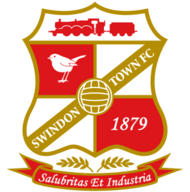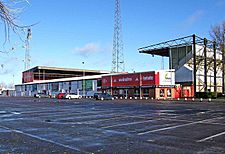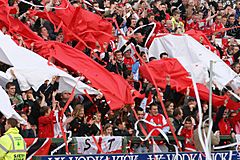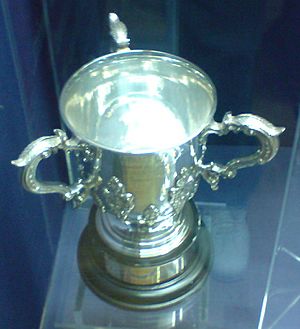Swindon Town F.C. facts for kids
 |
|||
| Full name | Swindon Town Football Club | ||
|---|---|---|---|
| Nickname(s) | The Robins | ||
| Founded | 1879 | ||
| Ground | The County Ground | ||
| Capacity | 15,728 | ||
| Owner | Clem Morfuni, Hollie Kiely & Bethany Parlodorio | ||
| Chairman | Clem Morfuni | ||
| Manager | Ian Holloway | ||
| League | League Two | ||
| 2018–19 | League Two, 13th of 24 | ||
|
|
|||
Swindon Town Football Club is a professional football team from Swindon, Wiltshire, England. They are often called "The Robins" because of their red and white team colours. Currently, they play in League Two, which is the fourth level of English football.
The club started in 1879 as Swindon AFC. It changed its name a couple of times before becoming Swindon Town in 1883. They became a professional team in 1894. Swindon Town won the Southern League twice before joining the Football League in 1920. They stayed in the third division for 43 years!
A big moment for the club was winning the League Cup in 1969. They beat Arsenal 3–1 in the final. This win helped them get promoted that same year. After some ups and downs, they even reached the top league, the Premier League, for the first time in 1993. However, they were relegated after just one season. Since then, Swindon Town has mostly played in the third and fourth levels of English football.
Their home colours are red and white. They have played at their home stadium, The County Ground, since 1896. The stadium can hold 15,728 fans. A famous player, John Trollope, played 770 league games for the club between 1960 and 1980. This was a record in English football for a long time!
Contents
Club History: Key Moments
How Swindon Town Started
Swindon Town Football Club was started by Reverend William Pitt in 1879. The team became professional in 1894 and joined the Southern League. In the 1909–10 season, Swindon reached the FA Cup semi-finals for the first time. They also won the Dubonnet Cup in Paris in 1910.
In the 1910–11 season, Swindon Town won the Southern League championship. This led to a special match against Football League champions Manchester United for the Charity Shield. Manchester United won 8–4 in a high-scoring game. Some money from this game helped survivors of the Titanic disaster. Swindon reached the FA Cup semi-finals again in 1912.
A very important player from this time was Harold Fleming. He played for Swindon from 1907 to 1924 and even played for the England national team 11 times. Swindon joined the Football League in 1920. They won their first game 9–1 against Luton Town, which is still a club record!
During World War II, the club's stadium, the County Ground, was used by the War Department. This made it hard for the club to recover after the war. They finally got promoted to the Second Division in 1963 but were relegated back to Division Three in 1965.
Winning the League Cup in 1969
In 1969, Swindon Town made history by beating Arsenal 3–1 to win the League Cup. This was the only time the club has won this trophy. Because they were not in the top division, they couldn't play in the main European competition. Instead, they played in new competitions called the Anglo-Italian competitions. Swindon won the 1969 Anglo-Italian League Cup and the 1970 Anglo-Italian Cup.
After this success, Swindon had a tough time and were relegated to the Fourth Division in 1982. But they bounced back! They won the Fourth Division title in 1986, scoring a record 102 points. The next year, they were promoted again.
In 1990, under manager Ossie Ardiles, Swindon won the Second Division play-off final. However, they were not allowed to be promoted to the top league due to some rule breaking. Later, an appeal allowed them to stay in the Second Division.
Reaching the Premier League
Glenn Hoddle became player-manager in 1991. He led the team to victory in the 1993 play-off final, which meant Swindon Town reached the Premier League for the first time ever!
However, their time in the Premier League was short. They were relegated after just one season, conceding 100 goals. They were then relegated again the next year, dropping into the third division. But they quickly won the Division Two championship in 1996 to get back to the second tier.
Recent Challenges and Successes
The club faced financial problems in the 2000s, including being placed into administration. In 2006, Swindon Town was relegated to League Two, becoming the first former Premier League team to drop to the lowest Football League division.
Paul Sturrock became manager in 2006 and led the team to promotion back to Football League One in his first season. In 2008, a new group of owners took over the club, aiming to clear its debts.
In the 2009–10 season, Swindon reached the League One play-off final at Wembley Stadium but lost 1–0. After some difficult seasons, including another relegation, Paolo Di Canio became manager in 2011. He led Swindon to win the League Two championship in 2012, getting them promoted again!
Di Canio left in 2013, and the club continued to have ups and downs. In the 2014–15 season, Swindon reached the League One Play-off final again but lost 4–0. They were relegated to League Two for a third time in 2017.
In 2020, Swindon were crowned League Two champions based on points per game, as the season was stopped due to the COVID-19 pandemic. However, financial difficulties continued, and they were relegated again in 2021.
In July 2021, Australian businessman Clem Morfuni took over the club. This brought new hope, and the club has been working to improve since then. They finished sixth in the 2021–22 season, reaching the play-off semi-finals. The club has had several managers since then, with Ian Holloway taking charge in 2024.
Team Kit and Badge
Club Badges and Their Meanings
Swindon Town has used several different badges over the years. The first badge showed a robin inside a shield. Later, they used a "steam train" badge, which looked like the town's official coat of arms. It featured a train (because Swindon is famous for railways), a football, and a robin. It also had a Latin motto: "Salubritas et Industria" (meaning "health and industry").
In the 1970s, they used a simpler "traffic sign" badge with the letters 'S' and 'T' linked together. The "steam train" badge returned in 1986. In 1991, a new "diamond" shaped badge was introduced to give the club a fresh look after financial problems. This badge had a "travelling" football and a green section.
In 2007, fans voted for a new badge. The winning design was similar to the old "steam train" badge. It includes the club name, a robin, a steam locomotive, a football, and the town's motto. This badge has been used since the 2007–08 season.
|
|
| Original home kit from 1879/80–1893/94 |
|
|
| 1894/95–1896/97 home kit |
|
|
| 1897/98–1900/01 home kit |
|
|
| 1901/02 home kit |
|
|
| 1902/03 home kit |
Home Kit Colours
Swindon Town first played in black and white. In 1894, they changed to black and red quarters. For a short time in 1897, they even wore green shirts with white sleeves.
Since 1901, Swindon Town has mostly worn red shirts. At first, it was a dark maroon, but in 1902, they chose a lighter red. This is when they started being called "the Robins," because of the bird's red chest.
The team has played in different styles of red and white kits over the years. Fans often call them the "Red and White Army." Green elements were added to the home kit in 1991 but were removed in 2007.
Away Kit Colours
Swindon's away kits have changed more often. Their first away kit was all blue. For the 1969 League Cup Final, they wore an all-white strip.
In the 1980s, they used white shirts with black shorts, and sometimes a yellow and blue third kit. When the club rebranded in 1991, they introduced a white and green away strip.
Away kits have varied, including black and gold stripes, and different shades of blue. In 2021–22, they released a gold and green checkered kit to honour the new Australian owner, Clem Morfuni. They also had a special all-black third kit, which was meant to show the club coming "out of the darkness" after the new ownership.
Shirt Sponsors and Manufacturers
Currently, Adidas makes Swindon Town's kits. Before that, Puma made them from 2015 to 2024. Many other companies have made their kits over the years. The club's shirts have also featured various sponsors, including well-known names like Samsung and EA Sports FIFA.
The County Ground: Swindon's Home Stadium
Swindon Town has played at The County Ground since 1896. Before that, they played on the nearby cricket pitch. A local businessman, Thomas Arkell, donated money to build the first stand.
Over the years, the stadium has been updated. A roof was added to the Town End in 1938. In 1940, during World War II, the ground was even used to house prisoners of war!
Swindon Town was the first League club to have floodlights in 1951. The current tall floodlight towers were put up in 1960. The County Ground is also unique because it has a Rolex watch on the Stratton Bank stand, celebrating their promotion in 1963.
For a long time, the club rented the land for the stadium from the local council. They had thought about moving to a new stadium they would own. However, on March 24, 2023, Swindon Town bought the County Ground for £2.3 million. This was a joint effort with TrustSTFC, the supporters' trust, giving fans a chance to own part of their home ground.
Swindon Town Supporters
Swindon Town has a dedicated fan base. In the past, up to 32,000 people would attend matches. However, stadium changes and team performance have affected attendance.
A group of core fans sits in the Town End of the stadium. They have created fan magazines over the years. Supporters call the team "The Town," "The Reds," "STFC," or the "Red and White Army." The Junior Robins is a club for younger fans, offering lower ticket prices and special activities.
The supporters' trust, TrustSTFC, was formed in 2000. This group of fans raises money for the club and helps supporters have a say in club decisions. They have schemes like the Red Army Fund, which helps buy new players. TrustSTFC also works with the club to improve the County Ground.
Another fan group, Red Army Loud and Proud, was formed to help bring back a great atmosphere to match days. They aim to be the "12th man on the pitch" and provide colourful flags for games.
Understanding Rivalries
Swindon Town has several rivalries with other football clubs. In 2013, a survey showed that Swindon has many rivals compared to other teams.
Their biggest rivals are Oxford United. Their matches are known as the A420 derby. These games are often very competitive and have seen some intense moments between fans over the years. As of 2025, Swindon has won more games against Oxford than they have lost. Swindon fans are sometimes called "moonrakers" by their rivals, but this is not seen as an insult in Wiltshire.
Reading is also a rival for many Swindon fans, but this rivalry has become less strong as the teams have often played in different leagues. The rivalries between Swindon, Reading, and Oxford were once called the "Didcot Triangle."
Swindon also has historical rivalries with Bristol City and Bristol Rovers. These rivalries are often felt more strongly by fans in areas of West Wiltshire where the fan bases overlap.
Other smaller rivalries include Gillingham, which started from a heated match in 1979. Recently, Newport County has become a minor rival. Teams from Gloucestershire like Cheltenham Town and Forest Green Rovers also see Swindon as a local rival. Other clubs in the West Country, like Plymouth Argyle and Exeter City, are also considered derby opponents.
Swindon Town Women's Team
Swindon Town Ladies FC started in 1993 and changed their name to Swindon Town Women in July 2019. The first team currently plays in the FA Women's National League South West Division 1. They play their home games at Foundation Park and the County Ground. In April 2023, the women's team officially became part of the main club.
Swindon Town Players
First Team Squad
|
|
For recent transfers, see 2025–26 Swindon Town F.C. season.
Players Out on Loan
|
Reserves and Academy Players
For more information: Swindon Town F.C. Reserves and Academy
|
|
Academy Players Out on Loan
|
Club Management Team
Club Officials
| Position | Name |
|---|---|
| Chairman | |
| "Person of Significant Interest" | |
| "Person of Significant Interest" | |
| Chief Executive | |
| Head of Football | |
| Manager | |
| Assistant Manager | |
| First Team Pathways Coach | |
| Goalkeeping Coach | |
| First-Team Physio | |
| First-Team Head of Performance | |
| First-Team Lead Analyst | |
| Commercial Manager | |
| Head of Media and Communications | |
| Official Club Photographer | |
| Kit Man | |
| Kit Man | |
| Chief Scout | |
| Academy Manager | |
| Assistant Academy Manager | |
| Academy Head of Coaching | |
| Academy Professional Development Phase Coach | |
| Academy Youth Development Phase Coach | |
| Academy Sports Scientist | |
| Academy Head of Recruitment | |
| Senior Academy Physiotherapist | |
| Club Ambassador |
Club Managers Through the Years
Many managers have led Swindon Town Football Club. Some, like Danny Williams and Andy King, have even managed the team twice!
 Sam Allen 1902–1933
Sam Allen 1902–1933 Ted Vizard 1933–1939
Ted Vizard 1933–1939 Neil Harris 1939–1940
Neil Harris 1939–1940 Louis Page 1945–1953
Louis Page 1945–1953 Maurice Lindley 1953–1955
Maurice Lindley 1953–1955 Bert Head 1956–1965
Bert Head 1956–1965 Danny Williams 1965–1969
Danny Williams 1965–1969 Fred Ford 1969–1971
Fred Ford 1969–1971 Dave Mackay 1971–1972 (Player-Manager)
Dave Mackay 1971–1972 (Player-Manager) Les Allen 1972–1974
Les Allen 1972–1974 Danny Williams 1974–1978
Danny Williams 1974–1978 Bobby Smith 1978–1980
Bobby Smith 1978–1980 John Trollope 1980–1983
John Trollope 1980–1983 Ken Beamish 1983–1984
Ken Beamish 1983–1984 Lou Macari 1984–1989 (Player-Manager)
Lou Macari 1984–1989 (Player-Manager) Osvaldo Ardiles 1989–1991 (Player-Manager)
Osvaldo Ardiles 1989–1991 (Player-Manager) Tony Galvin 1991 (Caretaker)
Tony Galvin 1991 (Caretaker) Glenn Hoddle 1991–1993 (Player-Manager)
Glenn Hoddle 1991–1993 (Player-Manager) John Gorman 1993–1994
John Gorman 1993–1994 Andy Rowland 1994 (Caretaker)
Andy Rowland 1994 (Caretaker) Steve McMahon 1994–1998 (Player-Manager)
Steve McMahon 1994–1998 (Player-Manager) Mike Walsh 1998 (Caretaker)
Mike Walsh 1998 (Caretaker) Jimmy Quinn 1998–2000 (Player-Manager)
Jimmy Quinn 1998–2000 (Player-Manager) Colin Todd 2000
Colin Todd 2000 Andy King 2000–2001
Andy King 2000–2001 Roy Evans 2001
Roy Evans 2001 Andy King 2001–2005
Andy King 2001–2005 Iffy Onuora 2005–2006
Iffy Onuora 2005–2006 Dennis Wise 2006
Dennis Wise 2006 David Tuttle 2006 (Caretaker)
David Tuttle 2006 (Caretaker) Ady Williams 2006 (Caretaker)
Ady Williams 2006 (Caretaker) Paul Sturrock 2006–2007
Paul Sturrock 2006–2007 David Byrne 2007–2008 (Caretaker)
David Byrne 2007–2008 (Caretaker) Maurice Malpas 2008
Maurice Malpas 2008 David Byrne 2008 (Caretaker)
David Byrne 2008 (Caretaker) Danny Wilson 2008–2011
Danny Wilson 2008–2011 Paul Hart 2011
Paul Hart 2011 Paul Bodin 2011 (Caretaker)
Paul Bodin 2011 (Caretaker) Paolo Di Canio 2011–2013
Paolo Di Canio 2011–2013 Fabrizio Piccareta 2013 (Caretaker)
Fabrizio Piccareta 2013 (Caretaker) Tommy Miller & Darren Ward 2013 (Joint Player-Caretakers)
Tommy Miller & Darren Ward 2013 (Joint Player-Caretakers) Kevin MacDonald 2013
Kevin MacDonald 2013 Mark Cooper 2013–2015
Mark Cooper 2013–2015 Lee Power 2015 (Caretaker)
Lee Power 2015 (Caretaker) Martin Ling 2015
Martin Ling 2015 Luke Williams 2015–2017
Luke Williams 2015–2017 David Flitcroft 2017–2018
David Flitcroft 2017–2018 Matt Taylor 2018 (Player-Caretaker)
Matt Taylor 2018 (Player-Caretaker) Phil Brown 2018
Phil Brown 2018 Richie Wellens 2018–2020
Richie Wellens 2018–2020 Noel Hunt 2020 (Caretaker)
Noel Hunt 2020 (Caretaker) John Sheridan 2020–2021
John Sheridan 2020–2021 Tommy Wright 2021 (Caretaker)
Tommy Wright 2021 (Caretaker) John McGreal 2021
John McGreal 2021 Ben Garner 2021–2022
Ben Garner 2021–2022 Scott Lindsey 2022–2023
Scott Lindsey 2022–2023 Gavin Gunning &
Gavin Gunning &  Steve Mildenhall 2023 (Joint-Caretaker)
Steve Mildenhall 2023 (Joint-Caretaker) Jody Morris 2023
Jody Morris 2023 Gavin Gunning &
Gavin Gunning &  Steve Mildenhall 2023 (Joint-Caretaker)
Steve Mildenhall 2023 (Joint-Caretaker) Michael Flynn 2023–2024
Michael Flynn 2023–2024 Gavin Gunning 2024 (Caretaker)
Gavin Gunning 2024 (Caretaker) Mark Kennedy 2024
Mark Kennedy 2024 Ian Holloway 2024–
Ian Holloway 2024–
Player Awards and Recognition
Swindon Town Hall of Fame
The Swindon Town Hall of Fame was started in 2011 to honour important players. The first three players to be included were Don Rogers, John Trollope, and Paul Bodin.
English Football Hall of Fame Members
Some players and managers connected to Swindon Town have also been inducted into the English Football Hall of Fame, which celebrates the best in English football.
|
|
Club Statistics and Records
John Trollope holds the record for playing the most games for Swindon Town, with 889 matches between 1960 and 1980. He also holds the English Football League record for most games played for one club (770 league games).
Harry Morris holds all of Swindon's goal-scoring records. He scored 229 goals for the club from 1926 to 1933. He also scored the most goals in a single season (48 in 1926–27).
The highest number of fans at the County Ground was 32,000. This happened on January 15, 1972, for an FA Cup match against Arsenal. Since the stadium's capacity is now 15,728, this record is unlikely to be broken.
Swindon Town has also set some interesting records in English football. They were the second team to score over 100 points in the League when they won the Fourth Division in 1985–86. They also hold the Premier League record for most goals conceded in a season (100 goals in 1993–94).
Club Honours and Trophies
League Titles
- Second Division / First Division (level 2)
- Play-off winners: 1990, 1993
- Third Division / Second Division (level 3)
- Champions: 1995–96
- Runners-up: 1962–63, 1968–69
- Play-off winners: 1987
- Fourth Division / League Two (level 4)
- Champions: 1985–86, 2011–12, 2019–20
- Promoted: 2006–07
- Southern League
- Champions: 1910–11, 1913–14
- Western League
- Champions: 1898–99
Cup Wins
- League Cup
- Winners: 1968–69
- Football League Trophy
- Runners-up: 2011–12
- FA Charity Shield
- Runners-up: 1911
- Anglo-Italian Cup
- Winners: 1970
- Anglo-Italian League Cup
- Winners: 1969
- Wiltshire County FA Senior Cup
- Winners: 1886–87, 1887–88, 1888–89, 1889–90, 1890–91, 1891–92, 1892–93, 1896–97, 1903–04, 1919–20
Images for kids
See also
 In Spanish: Swindon Town Football Club para niños
In Spanish: Swindon Town Football Club para niños












